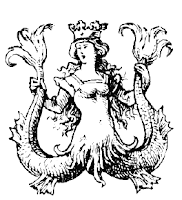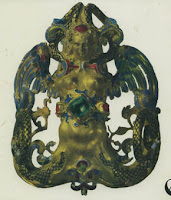In news that no doubt had you at the edge of your seats all day, Starbucks today unveiled a brand new logo that will be used on all cups at coffee retail locations beginning in March. Well, actually not a brand new logo. More like a modified iteration of their old logo by dropping the words “Starbucks Coffee.” Apparently, like McDonald’s “Golden Arches,” Nike’s “Swoosh,” and the artist formerly known as “The Artist Formerly Known as Prince,” Starbucks has decided that after 40 years it has finally reached sufficient brand saturation that it can drop the words altogether and simply emphasize the figure at the heart of the logo.
But what exactly is that figure?
Starbucks calls their iconic figure a Siren, a creature from Greek mythology whose enchanting voices lured sailors and their ships to doom, shipwrecked on the rocky coasts of their islands. Perhaps a wee morbid a thought to go along with your morning cup of Starbucks House Blend and scone. But considering my own caffein addiction, I guess it’s pretty apt.
The Starbucks icon is a particular species of siren, however, known as a Melusine. How do I know this? Well, it turns out that almost three years ago to the day, I was writing about Starbucks and Melusines over on my old blog. Since there’s serendipity not just on account of the Starbuck’s logo reboot but also because three years ago I was preparing to attend Science Online 2008 (next week I’ll once again be joining friends and colleagues in North Carolina for the Science Online 2011 Conference), I thought I’d resurrect this vintage post for your enjoyment.
Sunday, January 13, 2008
In what has become an all too common occurrence, I’m sitting in my office on a Sunday as I try to get a jump on the next couple of weeks of work. I leave Friday morning for North Carolina to attend the Science Blogging Conference where I’ll be co-presenter of a session called Real-time Blogging in the Marine Sciences. I’ll be joining forces with a distinguished cohort of other ocean bloggers who I am meeting face-to-face for the first time. It should be a blast. But then I return to San Francisco long enough to change my underwear before re-boarding a plane back to Washington DC for the International Coral Reef Initiative annual meeting and official launch of International Year of the Reef. Yeah, so it’s gonna be a busy couple of weeks.
Since it’s Sunday, none of the Peets Coffee stores are open in the neighborhood. If you’re a coffee addict and unfamiliar with Peets, I suggest you get online and place an order of these deeply roasted (some might say slightly burned) beans. Once you get hooked on the full frontal assault of this Bay Area roast, there’s no going back to weak, watery coffee. But in a pinch, I can stave-off caffeine withdrawal with substandard coffee (like Starbucks) by fortifying it with a couple shots of espresso.
But coffee snobbery and addiction is not the point of this post. What got me writing was that in between sips, I took note of the Starbucks logo closely for the first time. Sure, I recognize that “Starbuck” was Captain Ahab’s first mate in Melville’s novel Moby-Dick. And I’m not blind to the fact that the Starbucks icon is a mermaid. Or is it? In the logo, a long-haired woman appears to be holding two fishy tails. That’s not the canonical mermaid. A little snooping was in order.

A quick dash to Wikipedia and a few other online sources indicates that what Starbucks is using as their trademark identity is in fact a Melusine. Melusine (or Melusina) is a figure of European legends and folklore, a feminine spirit of fresh waters in sacred springs and rivers. She is usually depicted as a woman who is a serpent or fish (much like a mermaid) from the waist down. She is also sometimes illustrated with wings, two tails, and sometimes referred to as a nixie. Curiously, the name Melusine is not just a category of creature, but the actual name of an individual from whom the “species” is later labeled. In fact, the Melusine has become a rather common icon for heraldry throughout Europe.
There are quite a few literary versions of the Melusine, ranging from Scottish heritage (stories of coastal creatures known as Selkies) to Germany (meriminni or meerfrau) . The Encyclopedia Mythica, an amazing online resource, tells a fabulous story of a Melusine from Medieval France, circa 1394. It’s my stand-out favorite primarily because of it’s classic fairy-tale beginning of “meet and marry” as well as its cast of bizarre offspring (with hilarious nicknames).
As the tale goes, once upon a time the fairy, Melusine, was the daughter of the fairy Pressyne and King Elynas of Albany. She became the fairy Queen of the forest of Colombiers in the French region of Poitou. One day, she and two of her subjects were guarding their sacred fountain when a young man, Raymond of Poitiers, burst out of the forest. Melusine spent the night talking with Raymond, and by dawn, they were betrothed, but with one condition. Melusine requested that Raymond promise that he would never see her on a Saturday. He agreed, and they were married.
Melusine brought her husband great wealth and prosperity. She built the fortress of Lusignan so quickly that it appeared to be made by magic. Over time, Melusine built many castles, fortresses, churches, towers and towns, each in a single night, throughout the region. She and Raymond had ten children, but each child was flawed. The eldest had one red eye and one blue eye, the next had an ear larger than the other, another had a lion’s foot growing from his cheek, and another had but one eye. The sixth son was known as Geoffrey-with-the-great tooth, as he had a very large tooth. In spite of the deformities, the children were strong, talented and loved throughout the land.
One day, Raymond’s brother visited him and made Raymond very suspicious about the Saturday activities of his wife. So the next Saturday, Raymond sought his wife, finding her in her bath where he spied on her through a crack in the door. He was horrified to see that she had the body and tail of a serpent from her waist down. He said nothing until the day that their son, Geoffrey-with-the-great tooth, attacked a monastery and killed one hundred monks, including one of his brothers. Raymond accused Melusine of contaminating his line with her serpent nature, thus revealing that he had broken his promise to her.
 As a result, Melusine turned into a fifteen-foot serpent, circled the castle three times, wailing piteously, and then flew away. She would return at night to visit her children, then vanish. Raymond was never happy again. Melusine appeared at the castle, wailing, whenever a count of Lusignan was about to die or a new one to be born. It was said that the noble line which originated with Melusine will reign until the end of the world. Her children included the King of Cyprus, the King of Armenia, the King of Bohemia, the Duke of Luxembourg, and the Lord of Lusignan.
As a result, Melusine turned into a fifteen-foot serpent, circled the castle three times, wailing piteously, and then flew away. She would return at night to visit her children, then vanish. Raymond was never happy again. Melusine appeared at the castle, wailing, whenever a count of Lusignan was about to die or a new one to be born. It was said that the noble line which originated with Melusine will reign until the end of the world. Her children included the King of Cyprus, the King of Armenia, the King of Bohemia, the Duke of Luxembourg, and the Lord of Lusignan.
And now, Melusine can hold a Carmel Macchiato and Soy Chai Latte to her bare bosom as her latest malformed progeny. The legend continues.






2 Replies to “A Tale of Starbucks, Sirens, and Geoffrey-With-The-Great Tooth”
Comments are closed.